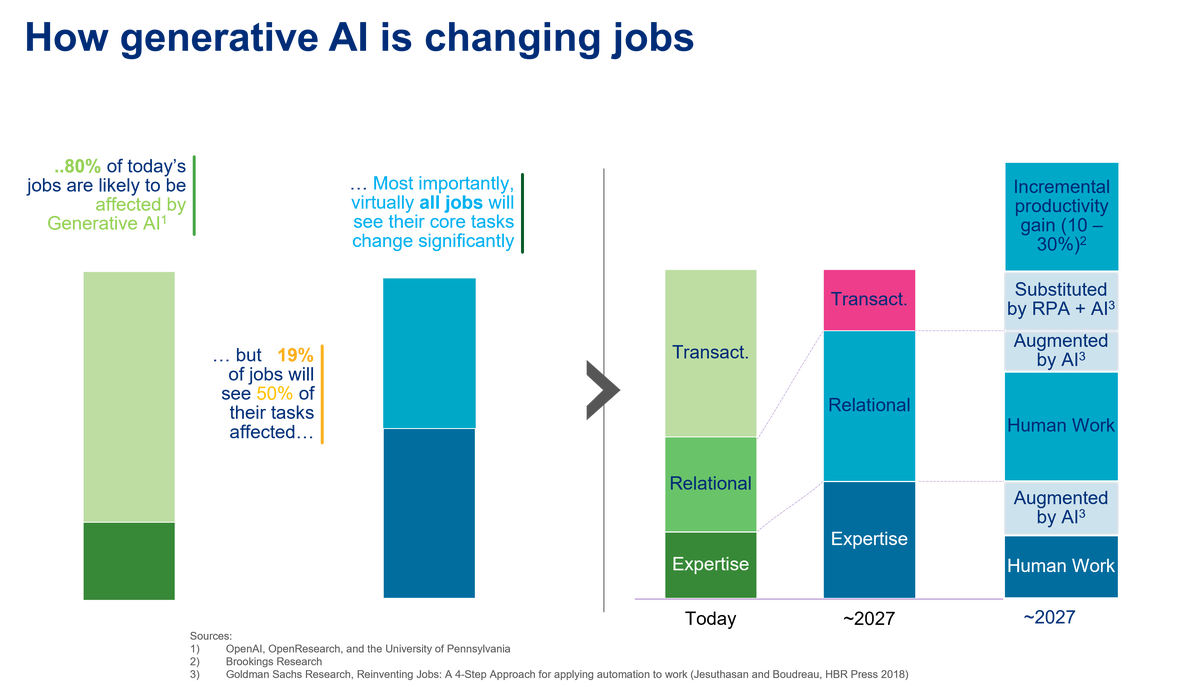Even by the relatively lofty standards of the tech sector, the hype around generative AI may have broken new ground. McKinsey estimate that the technology could add between $2.6tn to $4.4tn of economic value annually across industries ranging from banking to life sciences. Chat GPT, probably the most well known example of generative AI, reached 100 million users 2 months after launch and by most estimates has over 1 billion users currently. The following analysis based on multiple recent studies and a framework for analyzing the impact of automation on work as described in Reinventing Jobs (HBR Press, 2018), illustrates the potentially significant gains possible through the use of RPA and the four generations of AI currently available to us (rule-based systems, machine learning, deep learning, and generative AI).
But how exactly will generative AI affect work? Answering this question requires an understanding of the differences between generative AI and the previous generations of AI. The following analysis1 illustrates the most significant differences
While earlier iterations of AI were helpful in predicting specific outcomes, the lack of reasoning that underpins generative AI means that its well documented hallucinations will remain a feature of the technology for the foreseeable future. To understand how best to use it requires us to understand the essential characteristics of work. As described in Reinventing Jobs, there are four distinct potential outcomes associated with any body of work:
- Error elimination — think of some of the work of an airline pilot — where the consequences of a mistake are high and there is significant potential for negative value to the organization from any deviation from an acceptable level of performance.
- Minimizing variance — such as transaction-processing work — where there is no value in improving performance beyond a target level.
- Improving productivity — the work of a salesperson, for example — where an improvement in performance yields a commensurate improvement in value to the organization.
- Achieving breakthroughs — think of highly creative work, such as data science — where a small improvement in performance has an exponentially large impact on value.
Established automation like Robotic Process Automation (RPA) can be helpful in substituting human endeavor in work where the objective is to reduce variance and there is a greater tolerance for risk. Consider the application of RPA to reduce the variance with which the highly repetitive, rules-based work of analyzing and synthesizing financial data is performed. Previous generations of AI have long been used to augment analytical work where productivity improvement or achieving a breakthrough is the goal. Consider how oncologists have used machine learning, trained on significant volumes of specific data and images, to exponentially increase the accuracy of cancer detection, not by replacing skills but by augmenting capabilities and increasing the premium on experience and expertise. However, when error elimination is the objective function for work, generative AI can be an extremely risk proposition. Its aforementioned hallucinations place an extremely high premium on human competency and care, reducing its value proposition significantly.
It is essential that leaders understand when to rely on — and when not to rely on — various technologies and the specific role they should have in either substituting, augmenting of transforming human work. Generative AI is most useful in democratizing knowledge and creativity through augmentation, lowering the skills premiums traditionally required for a variety of creative tasks where the goal is achieving productivity gains and seeking a breakthrough in domains where there is a high tolerance for risk. It can be a valuable tool for boosting productivity where the tolerance for risk is higher. Compelling use cases have ranged from copywriting to call center operations where it has demonstrated significant value in boosting productivity particularly for the least experienced talent.
Interestingly, this democratization of access could have the benefit of reducing the rising inequality we have experienced over the last 2 industrial revolutions as generative AI increases the productivity of talent with lesser skills, much as the automation of the second-industrial revolution did. As AI continues to lower the premium on creativity and democratizes access, how will you ensure the perpetual reinvention of your business model and workforce to take advantage of it in a thoughtful and nuanced way?
1) Sources:
•Generative AI: How It works, History, and Pros and Cons, Investopedia, 2023
•How Generative AI is Changing Creative Work, Harvard Business Review, 2023
•Generative AI at Work, NBER, 2023
Read the full article here





